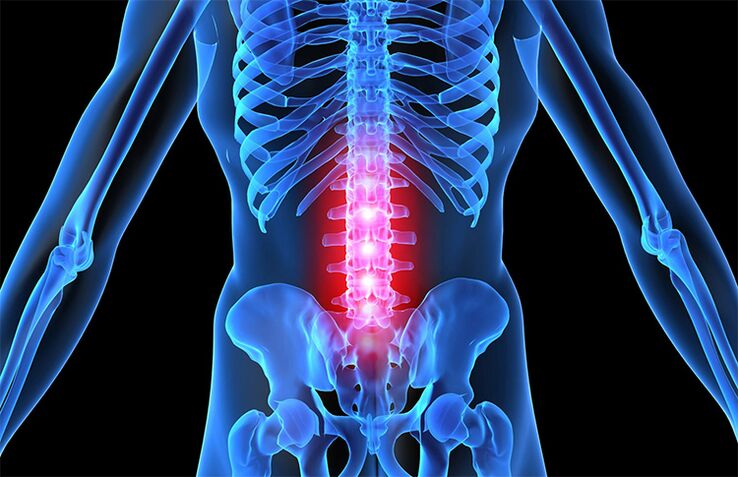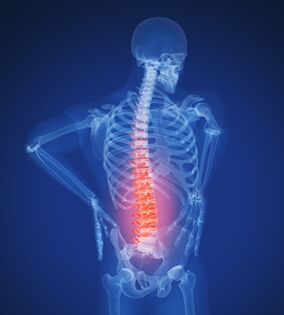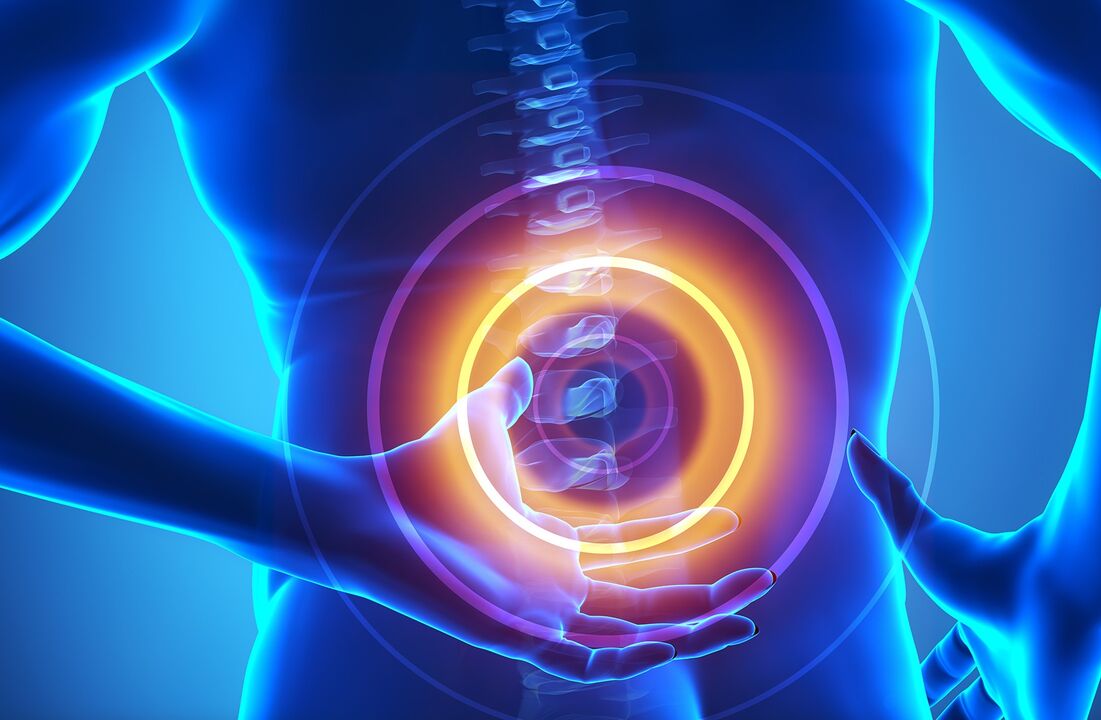
Thirty years later, many people have experienced back pain at least once. By the age of sixty, this disorder occurs in 80% of people. Almost always the cause is lumbar osteochondrosis. This leads to the development of pathologically unpleasant symptoms and can significantly worsen the quality of human life. It is extremely important to see a doctor in time to prevent the development of adverse effects.
Clinical features of lumbar spine osteochondrosis
The disease is widespread because the lower back suffers the most from high loads. There are five vertebrae in the lumbar region, in addition it connects the sacrum with the thoracic region. The intervertebral discs, consisting of the pulposus nucleus, give it elasticity. These elements are localized inside the fibrous ring.
Osteochondrosis causes malnutrition in the discs. For this reason, they are less elastic. In addition, their height decreases. Reducing the distance between the vertebrae causes damage to the nerve roots. As a result, there is pain in the lower back.
In the early stages, the symptoms of osteochondrosis are mild and may even disappear completely. However, further progression of the disease causes pain in the back and legs, and numbness may develop.
After the spread of changes, the likelihood of spinal correction decreases. Sometimes tears and subluxations appear - these disorders are associated with pain. Later, the disc may even rupture and the nerve endings may become compressed.
With the further development of the disease, blood vessels, ligaments and the spinal cord begin to participate in the process. Bone growth may develop. In the final stage, paralysis and paresis develop. Sometimes the function of the pelvic organs is impaired.
In young people, the disease is constantly progressing. In old age, despite the changes, the pathology can not manifest itself in any way. If treatment is not started on time, very dangerous consequences can occur.
Degrees
The pathology is irreversible and its symptoms are determined directly by the degree:
- First degree. During this period, pathological processes occur in the pulposus nucleus. There is concern about irritation of the nerve endings. They can be sharp or painful in nature. If spasms of the large arteries of the thigh occur, blood circulation is disrupted, which is fraught with the appearance of vascular pathology of the legs.
- Second degree. The destruction of the fibrous ring is advancing. Due to the loss of stability, the vertebrae become very mobile. As a result, muscle tissue is overloaded. The patient has high fatigue and discomfort of the lower back muscles.
- Third degree. The fibrous ring breaks, causing the pulp nucleus to release its contents. This process leads to the formation of hernias. There are radicular syndromes. At first, the patient feels hypersensitivity, burning sensation, tingling, numbness in the affected area. Sometimes the sensitivity may disappear completely. In severe cases, paralysis and muscle atrophy develop.
- Fourth degree. The function of the spine, joints and ligaments is impaired. Joint arthrosis develops. The pain may disappear, the supporting function of the spine is restored, but the amplitude inside is significantly reduced. The fourth degree is characterized by various symptoms of the disease.
Reasons

More than a third of patients with such osteochondrosis have liver or digestive problems. In the presence of such deviations, tension and spasms of muscles and blood vessels occur, which leads to oxygen deficiency and the appearance of dystrophic abnormalities. These processes are complicated by metabolic disorders.
The appearance of this form of osteochondrosis is often the result of obstruction in the pelvic organs. They can be associated with constipation, colitis, hemorrhoids. In women, such problems are caused by inflammation of the appendages, and in men by prostatitis.
The causes of osteochondrosis are as follows:
- Lack of physical activity.
- Diseases of the joints.
- Digestive problems.
- Back injury.
- Cardiovascular pathology.
- Diseases of the endocrine system.
- Problems with the spine.
- Inflammation.
- Straight legs.
- Increased physical activity.
- Metabolic disorders.
- Age changes.
There are also risk factors that significantly increase the likelihood of developing lumbar osteochondrosis:
- overweight;
- heredity;
- irrational nutrition;
- posture disorder;
- stay in a restless state for a long time;
- chronic sleep deprivation;
- frequent stress;
- hypothermia.
Symptoms and signs
The disease manifests itself in the form of pain syndrome, which can be of a different nature. Osteochondrosis is characterized by pulling, pain, cutting sensations. Anxiety can be felt not only in the legs, but also in the coccyx or lower chest.
The photo shows the pain syndrome in osteochondrosis of the lumbar region

In addition to pain, there are such disorders:
- muscle tension;
- problems in the reproductive system;
- menstrual disorders in women;
- constipation;
- change in posture;
- asymmetry of the hips;
- loss of sensitivity;
- tiredness;
- tingling and coldness in the legs;
- loss of activity;
- insomnia;
- emotional instability.
Exacerbation of osteochondrosis is usually the result of careless movement or high load. Also, recurrence of the disease often occurs due to hypothermia. Acute pain can not be felt only in the lower back - it often affects the lower extremities. During an exacerbation, a person tries to find a comfortable position to achieve pain relief.
Symptoms of lumbosacral osteochondrosis
This form of the disorder is also characterized by back pain. They can be felt in the lower back or in the foot near the sciatic nerve. Manifestations of the disease do not occur immediately, but approximately in the second stage of disease development.
At first they are felt during careless movements or loads. But over time, the pain is constant and painful. Sometimes there are exacerbations when the anxiety is more pronounced. In advanced cases, pain appears during sneezing, coughing, light tension.
When the nerve endings are constricted, a radicular syndrome develops, characterized by the following manifestations:
- shooting from behind;
- loss of sensation in the limbs;
- tingling in the legs;
- weakening of tendon reflexes;
- sweating disorders;
- cold feet;
- muscle weakness.
As the disease progresses, the back loses its elasticity, and any change in body position or load causes severe pain. As a result, mobility is limited, a person has difficulty bending, muscle spasms.
Effects
If you ignore the symptoms of osteochondrosis, sooner or later the disease will lead to negative consequences. As the distance between the vertebrae decreases, the arteries constrict, causing problems with the nutrition of the spinal cord.
As a result, there is pain, muscle weakness, loss of reflexes. Enuresis, incontinence, paralysis of the lower extremities may develop.
Another dangerous complication is a hernia. It also provokes severe pain and compression of the spinal cord. As a result, the legs may lose sensitivity, reflexes disappear. Sometimes the organs of the reproductive and urinary systems are disturbed. Digestive problems can also occur.
This form of osteochondrosis can cause instability of the spine. Under the influence of gravity, it appears to slip from the lower back sacrum. For women, this situation is fraught with problems with the internal organs - the ovaries, uterus, appendages. In men, this disorder can lead to impotence.
Lumbar osteochondrosis often causes problems with blood circulation in the spinal cord. Another result is compression myelopathy. Problems arise in the spinal cord due to the narrowing of the spinal canal.
However, the most complicated situation is "ponytail" syndrome, which is considered to be the result of nerve root damage. In advanced cases, it can lead to paralysis and paresis of the extremities.
Diagnostic methods
To diagnose osteochondrosis, the doctor examines the patient's medical history and conducts a visual examination. General urine and blood tests are also performed. With their help, other serious diseases can be ruled out.
An important criterion is the assessment of the condition of the feet. It is important to determine the condition of the skin, blood vessels, muscle tone. Women are additionally referred to a gynecologist. Men should be examined by a urologist.
The following types of diagnostics are required:
- radiography;
- CT scan;
- Magnetic resonance imaging.
How to treat
Medical, physiotherapeutic and surgical methods can be used to treat the disease. The main goal is to eliminate the manifestations of the disease and prevent its development.
Anti-inflammatory and analgesic drugs are used. Make sure you take B vitamins. Sedatives and anticonvulsants are used to cope with psychogenic disorders. Novocaine blockade may be used during exacerbation.
Of the non-drug treatments, therapeutic exercises, acupuncture and massage are the most effective. You can also do electrophoresis and phonophoresis. If conservative methods do not work, surgery is performed.
Lumbar osteochondrosis is considered a very dangerous pathology that can lead to extremely negative consequences for health. To prevent this, it is very important to consult a doctor if you have any back problems.


















